Marketing Fundamentals: H&M's Marketing Process and Stakeholder Impact
VerifiedAdded on 2023/01/05
|15
|4542
|82
Essay
AI Summary
This essay provides a comprehensive overview of marketing fundamentals, focusing on the marketing process and the significance of the marketing mix. It explores the various stages of the marketing process, including setting a mission, situational analysis (SWOT, PESTEL, and 5C's), and marketing planning (STP strategy). The essay then delves into the elements of the marketing mix: product, price, promotion, and place, highlighting their importance in achieving organizational success. Furthermore, it analyzes the impact of stakeholders on marketing activities and their engagement in business, using Hennes & Mauritz (H&M) as a case study to illustrate these concepts. The analysis includes H&M's mission, its responses to various environmental factors, competitor analysis, and its approach to segmentation, targeting, and positioning. The essay concludes by summarizing the key takeaways regarding the marketing process, marketing mix, and stakeholder management within a global retail context.
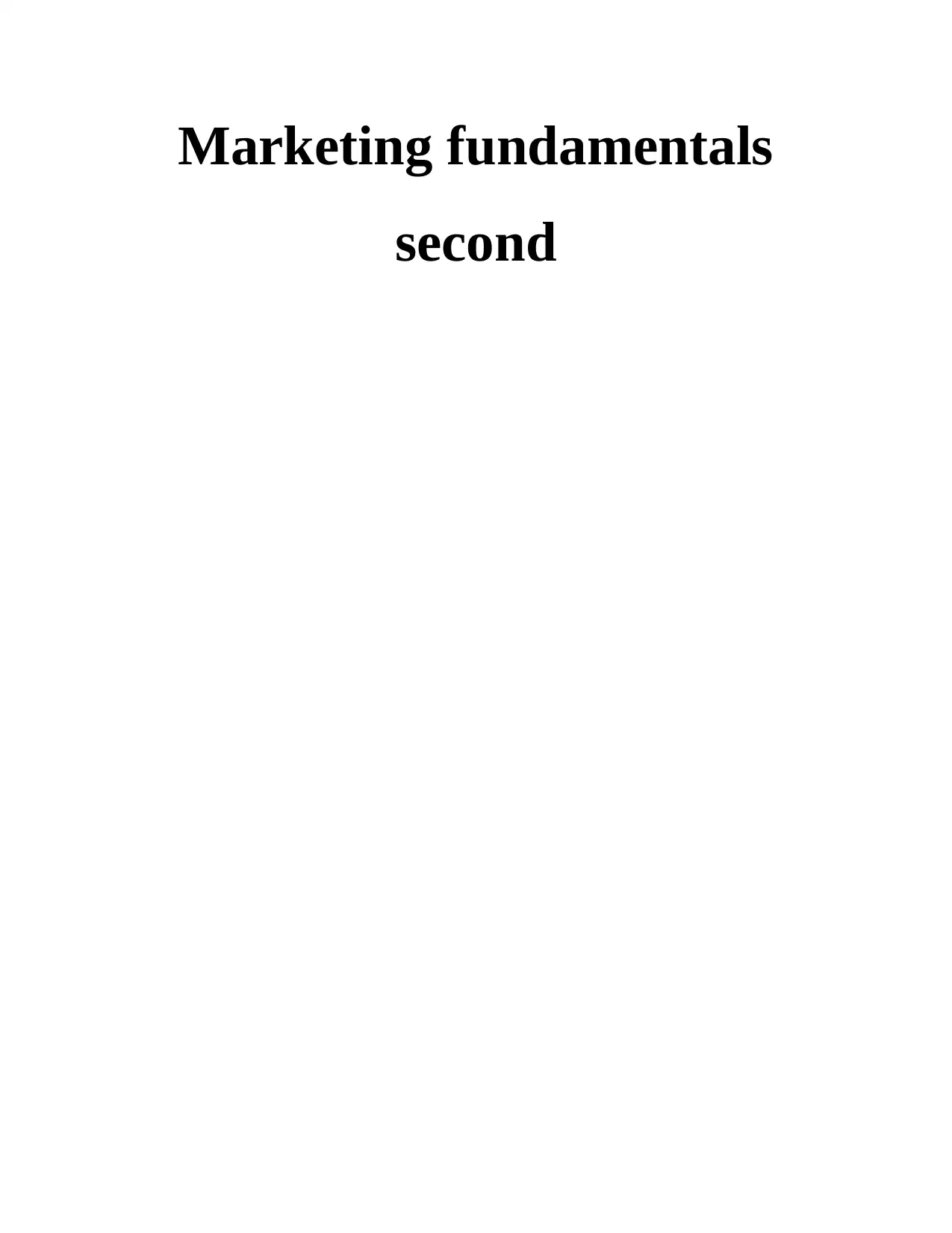
Marketing fundamentals
second
second
Paraphrase This Document
Need a fresh take? Get an instant paraphrase of this document with our AI Paraphraser
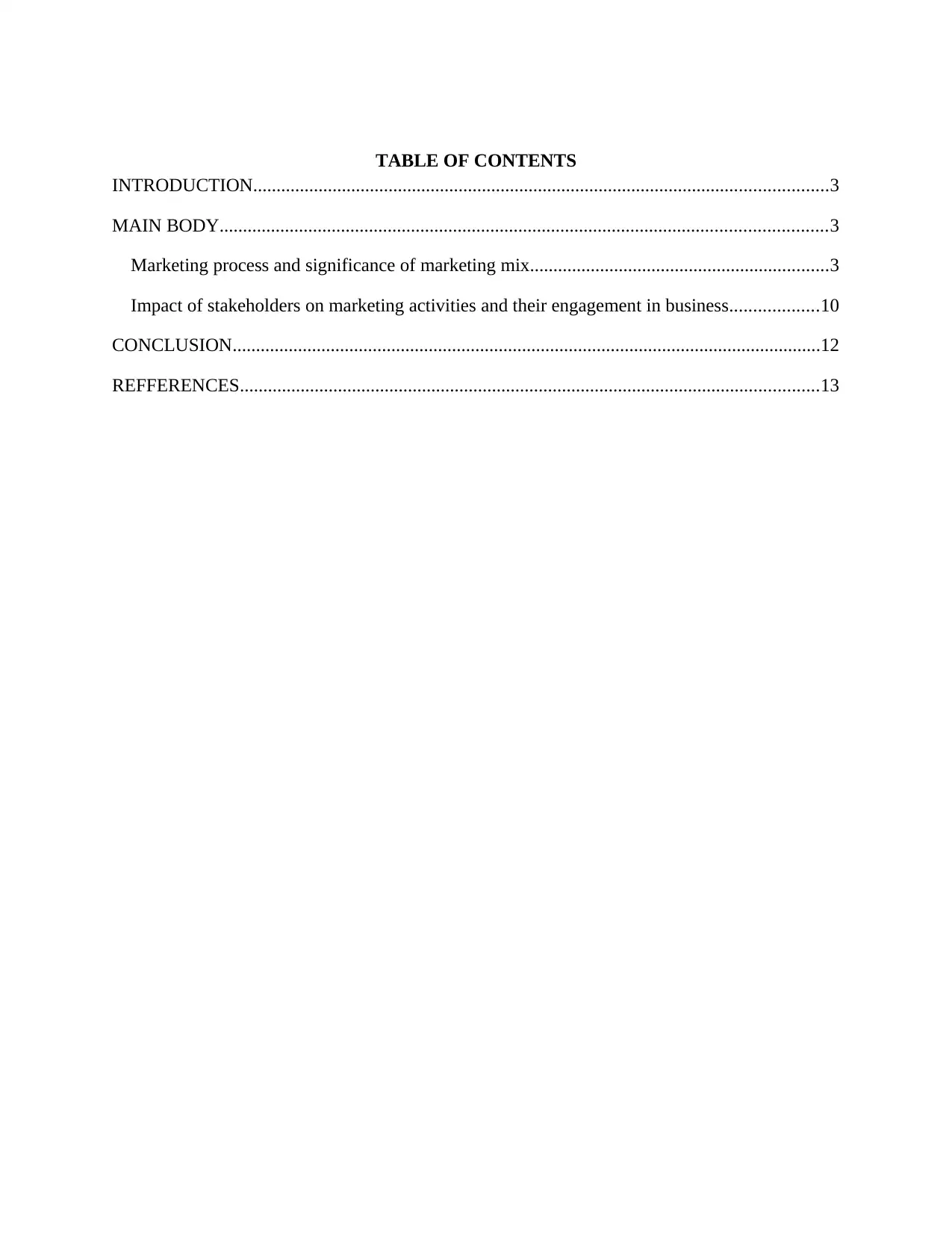
TABLE OF CONTENTS
INTRODUCTION...........................................................................................................................3
MAIN BODY..................................................................................................................................3
Marketing process and significance of marketing mix................................................................3
Impact of stakeholders on marketing activities and their engagement in business...................10
CONCLUSION..............................................................................................................................12
REFFERENCES............................................................................................................................13
INTRODUCTION...........................................................................................................................3
MAIN BODY..................................................................................................................................3
Marketing process and significance of marketing mix................................................................3
Impact of stakeholders on marketing activities and their engagement in business...................10
CONCLUSION..............................................................................................................................12
REFFERENCES............................................................................................................................13
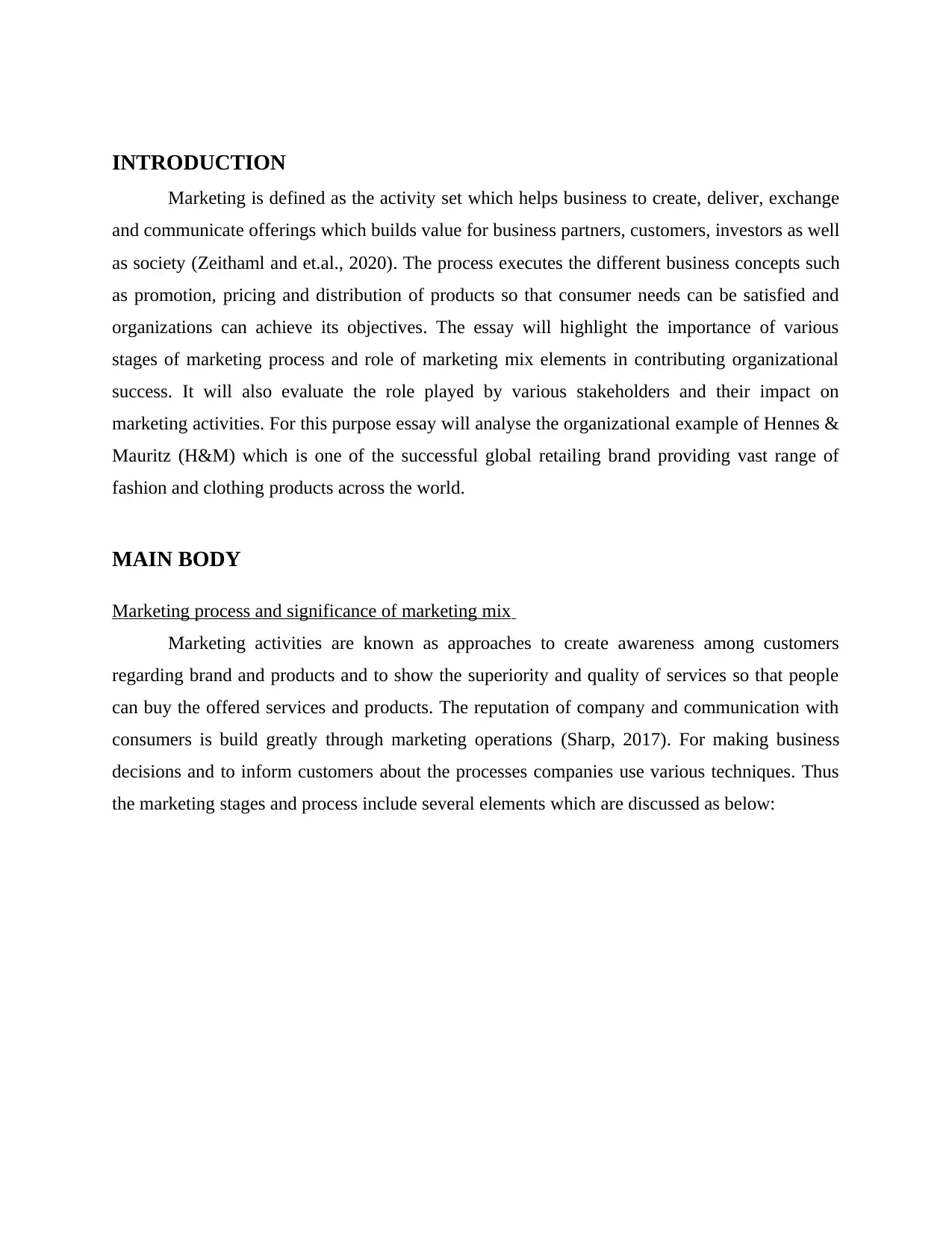
INTRODUCTION
Marketing is defined as the activity set which helps business to create, deliver, exchange
and communicate offerings which builds value for business partners, customers, investors as well
as society (Zeithaml and et.al., 2020). The process executes the different business concepts such
as promotion, pricing and distribution of products so that consumer needs can be satisfied and
organizations can achieve its objectives. The essay will highlight the importance of various
stages of marketing process and role of marketing mix elements in contributing organizational
success. It will also evaluate the role played by various stakeholders and their impact on
marketing activities. For this purpose essay will analyse the organizational example of Hennes &
Mauritz (H&M) which is one of the successful global retailing brand providing vast range of
fashion and clothing products across the world.
MAIN BODY
Marketing process and significance of marketing mix
Marketing activities are known as approaches to create awareness among customers
regarding brand and products and to show the superiority and quality of services so that people
can buy the offered services and products. The reputation of company and communication with
consumers is build greatly through marketing operations (Sharp, 2017). For making business
decisions and to inform customers about the processes companies use various techniques. Thus
the marketing stages and process include several elements which are discussed as below:
Marketing is defined as the activity set which helps business to create, deliver, exchange
and communicate offerings which builds value for business partners, customers, investors as well
as society (Zeithaml and et.al., 2020). The process executes the different business concepts such
as promotion, pricing and distribution of products so that consumer needs can be satisfied and
organizations can achieve its objectives. The essay will highlight the importance of various
stages of marketing process and role of marketing mix elements in contributing organizational
success. It will also evaluate the role played by various stakeholders and their impact on
marketing activities. For this purpose essay will analyse the organizational example of Hennes &
Mauritz (H&M) which is one of the successful global retailing brand providing vast range of
fashion and clothing products across the world.
MAIN BODY
Marketing process and significance of marketing mix
Marketing activities are known as approaches to create awareness among customers
regarding brand and products and to show the superiority and quality of services so that people
can buy the offered services and products. The reputation of company and communication with
consumers is build greatly through marketing operations (Sharp, 2017). For making business
decisions and to inform customers about the processes companies use various techniques. Thus
the marketing stages and process include several elements which are discussed as below:
⊘ This is a preview!⊘
Do you want full access?
Subscribe today to unlock all pages.

Trusted by 1+ million students worldwide

Figure 1 Marketing process stages
(Source: Weller, 2017)
Setting a clear mission: The first stage of marketing process is to have a well defined mission so
that customers and employees can be motivated. This element of marketing is very important as
it guides company that in which direction all business activities must be formulated by
management and operational team. The mission statement of H&M is to ensure that extremely
good quality living conditions are accessible to all individuals (H&M mission and vision
statement analysis, 2020). It regularly encourages employees that their first priority must be
quality services and also provide a sense of trust to consumers that services of company will be
satisfactory. The mission statement of H&M focuses the betterment of community and people by
providing good quality designs and fashions.
Situational analysis:
The next stage in marketing process involves situational analysis which helps
organisation to understand and identify both internal as well as external factors affecting
business. Situational analysis stage is one of the crucial elements of marketing process as it helps
companies to understand the market and consumer needs and to improve business process,
objectives and vision accordingly (Brown, 2020). For this purpose companies uses variety of
models and approaches. Some of the most commonly used models are as follows:
(Source: Weller, 2017)
Setting a clear mission: The first stage of marketing process is to have a well defined mission so
that customers and employees can be motivated. This element of marketing is very important as
it guides company that in which direction all business activities must be formulated by
management and operational team. The mission statement of H&M is to ensure that extremely
good quality living conditions are accessible to all individuals (H&M mission and vision
statement analysis, 2020). It regularly encourages employees that their first priority must be
quality services and also provide a sense of trust to consumers that services of company will be
satisfactory. The mission statement of H&M focuses the betterment of community and people by
providing good quality designs and fashions.
Situational analysis:
The next stage in marketing process involves situational analysis which helps
organisation to understand and identify both internal as well as external factors affecting
business. Situational analysis stage is one of the crucial elements of marketing process as it helps
companies to understand the market and consumer needs and to improve business process,
objectives and vision accordingly (Brown, 2020). For this purpose companies uses variety of
models and approaches. Some of the most commonly used models are as follows:
Paraphrase This Document
Need a fresh take? Get an instant paraphrase of this document with our AI Paraphraser

SWOT analysis: This approach is used by firms to assess the internal capabilities and
performance of organisation. Its key elements are:
Strength: This part of analysis describes the competitive advantage or superior elements of
organisation. For instance H&M has strong appearance and brand image among customers.
Further significant market share and vast range of products is key feature which helps company
to maintain competitive positioning in the market.
Weakness: By analysing weakness companies can identify the factors limiting their success. It is
important part of the marketing process so that performance gaps can be identified and marketing
process can fill these gaps (Keller, Halkier and Wilska, 2016). Like one of the weaknesses of
H&M is that it has premium pricing strategy and thus only a very small segment of customers is
able to connect with it. Organisation must come up with new product range for other customers
also which at present avoid choosing H&M due to its pricing. However with the identification of
this weakness marketing team can use approaches like digital marketing and social media,
discount coupons, new low price stores to make it more advanced, technology dependent and
popular among people.
Opportunity: It helps to gain benefits of untapped markets and to increase profitability. Through
marketing process H&M can identify that it has huge opportunity to increase investment in Asian
countries. The suitable marketing actions in this direction can strengthen company’s
performance.
Threat: Marketing analysis also allow organisation to trace obstacles in the path of growth and
to eliminate them (Chanavat, Desbordes and Lorgnier, 2017). For instance huge competition in
online fashion retail sector is one of the key threats which can completely destroy the
organisation. Thus it is vital that H&M must identify this threat and timely actions such as
loyalty coupons, quality improvement price cutting must be taken to overcome this.
PESTEL analysis: Apart from the internal analysis marketing process also includes evaluation of
the external business factors which controls the action of the firm (Gómez-Suárez, Martínez-
Ruiz and Martínez-Caraballo, 2017). This can be done by using PESTEL model.
performance of organisation. Its key elements are:
Strength: This part of analysis describes the competitive advantage or superior elements of
organisation. For instance H&M has strong appearance and brand image among customers.
Further significant market share and vast range of products is key feature which helps company
to maintain competitive positioning in the market.
Weakness: By analysing weakness companies can identify the factors limiting their success. It is
important part of the marketing process so that performance gaps can be identified and marketing
process can fill these gaps (Keller, Halkier and Wilska, 2016). Like one of the weaknesses of
H&M is that it has premium pricing strategy and thus only a very small segment of customers is
able to connect with it. Organisation must come up with new product range for other customers
also which at present avoid choosing H&M due to its pricing. However with the identification of
this weakness marketing team can use approaches like digital marketing and social media,
discount coupons, new low price stores to make it more advanced, technology dependent and
popular among people.
Opportunity: It helps to gain benefits of untapped markets and to increase profitability. Through
marketing process H&M can identify that it has huge opportunity to increase investment in Asian
countries. The suitable marketing actions in this direction can strengthen company’s
performance.
Threat: Marketing analysis also allow organisation to trace obstacles in the path of growth and
to eliminate them (Chanavat, Desbordes and Lorgnier, 2017). For instance huge competition in
online fashion retail sector is one of the key threats which can completely destroy the
organisation. Thus it is vital that H&M must identify this threat and timely actions such as
loyalty coupons, quality improvement price cutting must be taken to overcome this.
PESTEL analysis: Apart from the internal analysis marketing process also includes evaluation of
the external business factors which controls the action of the firm (Gómez-Suárez, Martínez-
Ruiz and Martínez-Caraballo, 2017). This can be done by using PESTEL model.

Political: Factors such as political instability due to Brexit can affect the import duties and other
trade regulations. In such situations companies like H&M may be forced to change their pricing
strategy to balance their profitability in UK.
Economic: The economic recessions and higher unemployment rates have direct impact over
purchasing power of the customers. Thus in such situations H&M is required to change their
marketing techniques and business processes so that prices can be made more affordable to
people. The failure to consider economic factor will decrease the sales and inventory
management of the organisation.
Social: It is also crucial for the business to understand the respond towards social changes so that
people can connect themselves with organisation. It is the result of marketing analysis that H&M
identifies the need of online shopping in fashion retailing and comfortable clothing products for
different types of customers (Dholakia, Dholakia and Chattopadhyay, 2018). In response to these
needs H&M has not only opened several stores across UK but also provide online purchasing,
home delivery and 24*7 services.
Technological: Marketing process also identifies the technological changes which can affect the
operations of business. For instance for winning opportunities H&M has identified and planned
to integrate artificial intelligence in decision making. It will help company to have better clarity
regarding consumer behaviour.
Environmental: Many times organisations fail to identify the significance and method of
environmental factors. External marketing analysis of H&M allows organisation to improve CSR
initiatives and to improve its operational efficiency (Decker and Stummer, 2017). Organisations
adopt processes which makes products from environmental friendly packaging and fabric.
Legal: For successful business it is mandatory for business to follow all necessary legal
requirements. These requirements are also identified by marketing processes. H&M is bound to
follow several legislations related to employment, data privacy and financial transactions
(Groening, Sarkis and Zhu, 2018). If marketing stages does not consider this factor then
organisation may face severe legal consequences of the same.
trade regulations. In such situations companies like H&M may be forced to change their pricing
strategy to balance their profitability in UK.
Economic: The economic recessions and higher unemployment rates have direct impact over
purchasing power of the customers. Thus in such situations H&M is required to change their
marketing techniques and business processes so that prices can be made more affordable to
people. The failure to consider economic factor will decrease the sales and inventory
management of the organisation.
Social: It is also crucial for the business to understand the respond towards social changes so that
people can connect themselves with organisation. It is the result of marketing analysis that H&M
identifies the need of online shopping in fashion retailing and comfortable clothing products for
different types of customers (Dholakia, Dholakia and Chattopadhyay, 2018). In response to these
needs H&M has not only opened several stores across UK but also provide online purchasing,
home delivery and 24*7 services.
Technological: Marketing process also identifies the technological changes which can affect the
operations of business. For instance for winning opportunities H&M has identified and planned
to integrate artificial intelligence in decision making. It will help company to have better clarity
regarding consumer behaviour.
Environmental: Many times organisations fail to identify the significance and method of
environmental factors. External marketing analysis of H&M allows organisation to improve CSR
initiatives and to improve its operational efficiency (Decker and Stummer, 2017). Organisations
adopt processes which makes products from environmental friendly packaging and fabric.
Legal: For successful business it is mandatory for business to follow all necessary legal
requirements. These requirements are also identified by marketing processes. H&M is bound to
follow several legislations related to employment, data privacy and financial transactions
(Groening, Sarkis and Zhu, 2018). If marketing stages does not consider this factor then
organisation may face severe legal consequences of the same.
⊘ This is a preview!⊘
Do you want full access?
Subscribe today to unlock all pages.

Trusted by 1+ million students worldwide
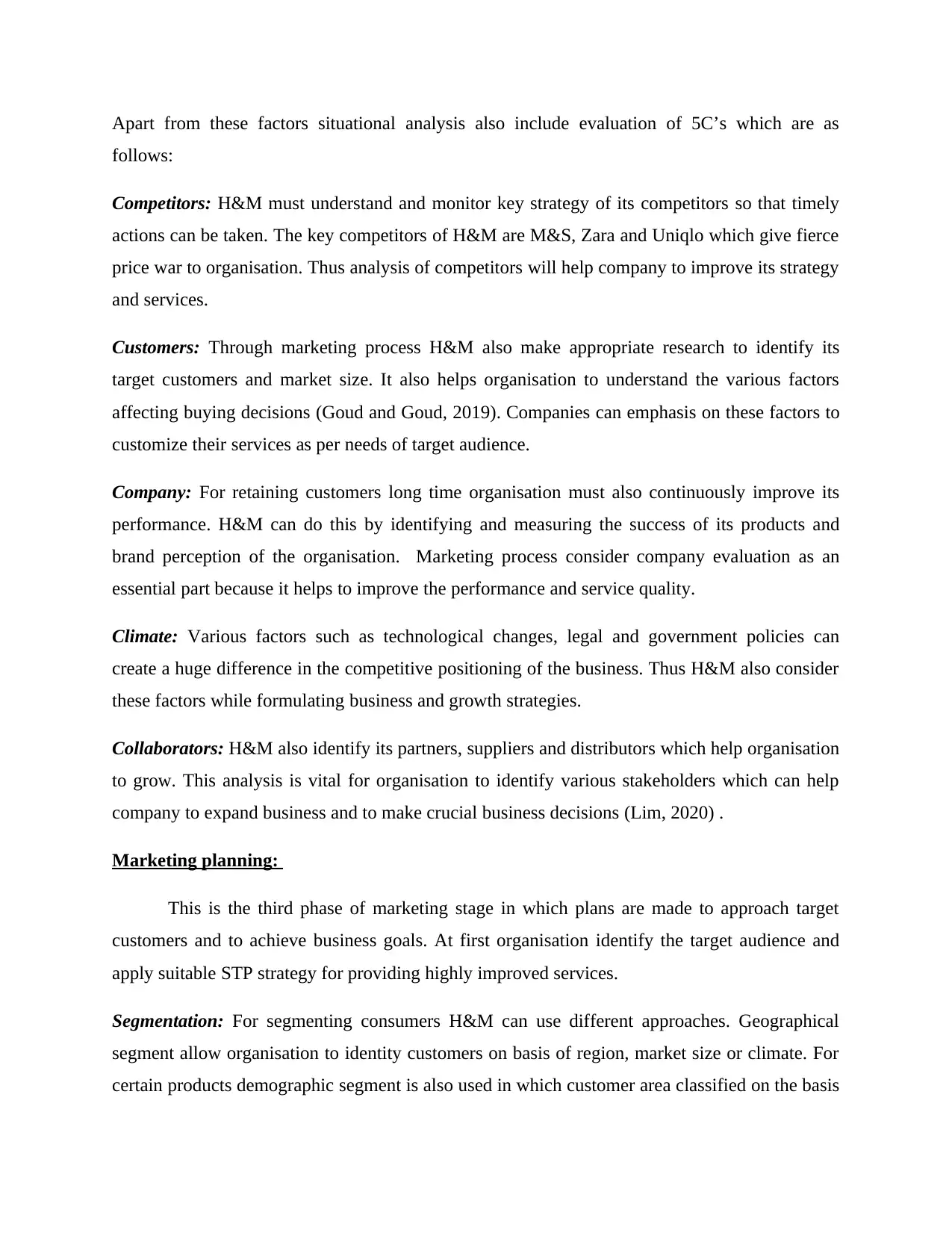
Apart from these factors situational analysis also include evaluation of 5C’s which are as
follows:
Competitors: H&M must understand and monitor key strategy of its competitors so that timely
actions can be taken. The key competitors of H&M are M&S, Zara and Uniqlo which give fierce
price war to organisation. Thus analysis of competitors will help company to improve its strategy
and services.
Customers: Through marketing process H&M also make appropriate research to identify its
target customers and market size. It also helps organisation to understand the various factors
affecting buying decisions (Goud and Goud, 2019). Companies can emphasis on these factors to
customize their services as per needs of target audience.
Company: For retaining customers long time organisation must also continuously improve its
performance. H&M can do this by identifying and measuring the success of its products and
brand perception of the organisation. Marketing process consider company evaluation as an
essential part because it helps to improve the performance and service quality.
Climate: Various factors such as technological changes, legal and government policies can
create a huge difference in the competitive positioning of the business. Thus H&M also consider
these factors while formulating business and growth strategies.
Collaborators: H&M also identify its partners, suppliers and distributors which help organisation
to grow. This analysis is vital for organisation to identify various stakeholders which can help
company to expand business and to make crucial business decisions (Lim, 2020) .
Marketing planning:
This is the third phase of marketing stage in which plans are made to approach target
customers and to achieve business goals. At first organisation identify the target audience and
apply suitable STP strategy for providing highly improved services.
Segmentation: For segmenting consumers H&M can use different approaches. Geographical
segment allow organisation to identity customers on basis of region, market size or climate. For
certain products demographic segment is also used in which customer area classified on the basis
follows:
Competitors: H&M must understand and monitor key strategy of its competitors so that timely
actions can be taken. The key competitors of H&M are M&S, Zara and Uniqlo which give fierce
price war to organisation. Thus analysis of competitors will help company to improve its strategy
and services.
Customers: Through marketing process H&M also make appropriate research to identify its
target customers and market size. It also helps organisation to understand the various factors
affecting buying decisions (Goud and Goud, 2019). Companies can emphasis on these factors to
customize their services as per needs of target audience.
Company: For retaining customers long time organisation must also continuously improve its
performance. H&M can do this by identifying and measuring the success of its products and
brand perception of the organisation. Marketing process consider company evaluation as an
essential part because it helps to improve the performance and service quality.
Climate: Various factors such as technological changes, legal and government policies can
create a huge difference in the competitive positioning of the business. Thus H&M also consider
these factors while formulating business and growth strategies.
Collaborators: H&M also identify its partners, suppliers and distributors which help organisation
to grow. This analysis is vital for organisation to identify various stakeholders which can help
company to expand business and to make crucial business decisions (Lim, 2020) .
Marketing planning:
This is the third phase of marketing stage in which plans are made to approach target
customers and to achieve business goals. At first organisation identify the target audience and
apply suitable STP strategy for providing highly improved services.
Segmentation: For segmenting consumers H&M can use different approaches. Geographical
segment allow organisation to identity customers on basis of region, market size or climate. For
certain products demographic segment is also used in which customer area classified on the basis
Paraphrase This Document
Need a fresh take? Get an instant paraphrase of this document with our AI Paraphraser
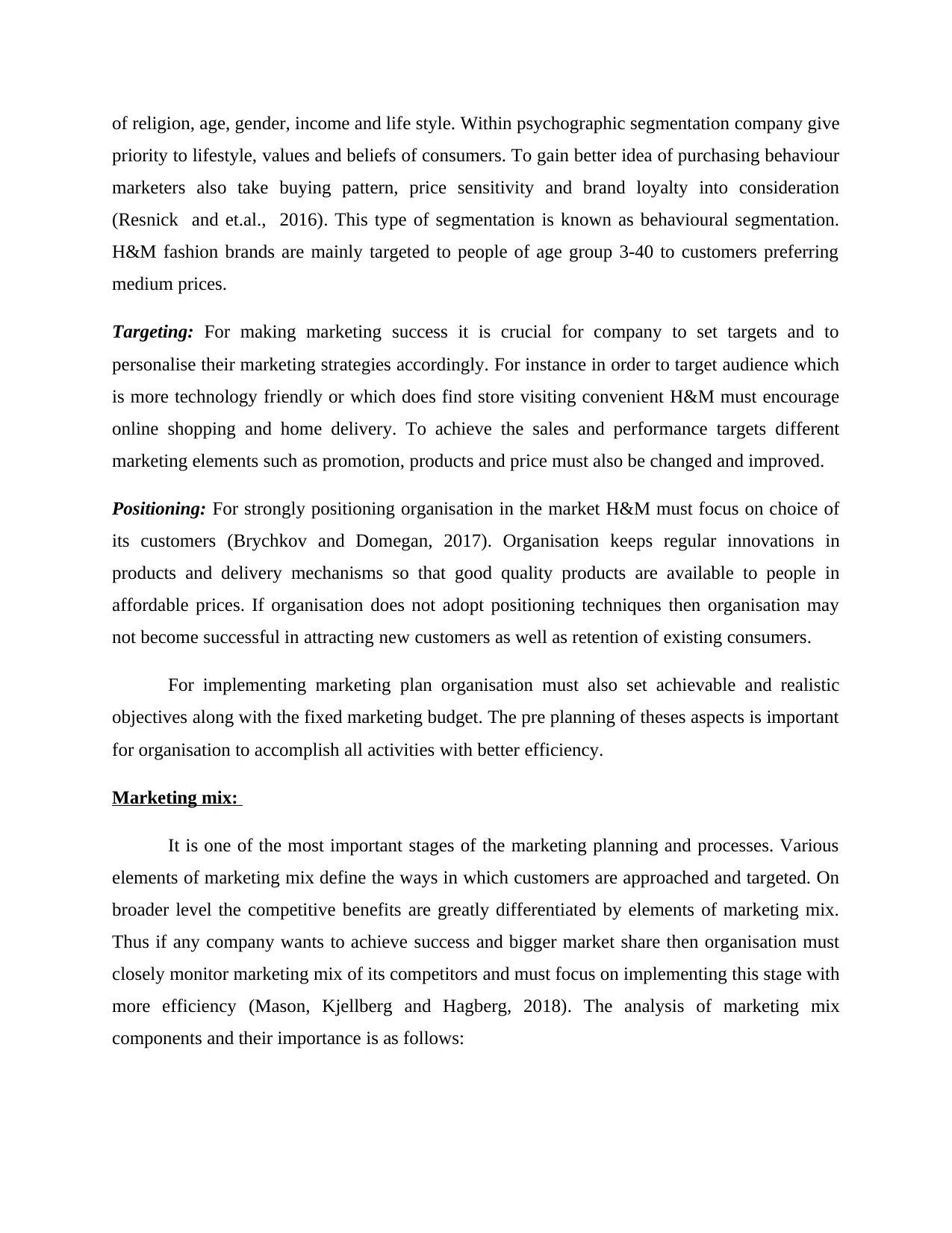
of religion, age, gender, income and life style. Within psychographic segmentation company give
priority to lifestyle, values and beliefs of consumers. To gain better idea of purchasing behaviour
marketers also take buying pattern, price sensitivity and brand loyalty into consideration
(Resnick and et.al., 2016). This type of segmentation is known as behavioural segmentation.
H&M fashion brands are mainly targeted to people of age group 3-40 to customers preferring
medium prices.
Targeting: For making marketing success it is crucial for company to set targets and to
personalise their marketing strategies accordingly. For instance in order to target audience which
is more technology friendly or which does find store visiting convenient H&M must encourage
online shopping and home delivery. To achieve the sales and performance targets different
marketing elements such as promotion, products and price must also be changed and improved.
Positioning: For strongly positioning organisation in the market H&M must focus on choice of
its customers (Brychkov and Domegan, 2017). Organisation keeps regular innovations in
products and delivery mechanisms so that good quality products are available to people in
affordable prices. If organisation does not adopt positioning techniques then organisation may
not become successful in attracting new customers as well as retention of existing consumers.
For implementing marketing plan organisation must also set achievable and realistic
objectives along with the fixed marketing budget. The pre planning of theses aspects is important
for organisation to accomplish all activities with better efficiency.
Marketing mix:
It is one of the most important stages of the marketing planning and processes. Various
elements of marketing mix define the ways in which customers are approached and targeted. On
broader level the competitive benefits are greatly differentiated by elements of marketing mix.
Thus if any company wants to achieve success and bigger market share then organisation must
closely monitor marketing mix of its competitors and must focus on implementing this stage with
more efficiency (Mason, Kjellberg and Hagberg, 2018). The analysis of marketing mix
components and their importance is as follows:
priority to lifestyle, values and beliefs of consumers. To gain better idea of purchasing behaviour
marketers also take buying pattern, price sensitivity and brand loyalty into consideration
(Resnick and et.al., 2016). This type of segmentation is known as behavioural segmentation.
H&M fashion brands are mainly targeted to people of age group 3-40 to customers preferring
medium prices.
Targeting: For making marketing success it is crucial for company to set targets and to
personalise their marketing strategies accordingly. For instance in order to target audience which
is more technology friendly or which does find store visiting convenient H&M must encourage
online shopping and home delivery. To achieve the sales and performance targets different
marketing elements such as promotion, products and price must also be changed and improved.
Positioning: For strongly positioning organisation in the market H&M must focus on choice of
its customers (Brychkov and Domegan, 2017). Organisation keeps regular innovations in
products and delivery mechanisms so that good quality products are available to people in
affordable prices. If organisation does not adopt positioning techniques then organisation may
not become successful in attracting new customers as well as retention of existing consumers.
For implementing marketing plan organisation must also set achievable and realistic
objectives along with the fixed marketing budget. The pre planning of theses aspects is important
for organisation to accomplish all activities with better efficiency.
Marketing mix:
It is one of the most important stages of the marketing planning and processes. Various
elements of marketing mix define the ways in which customers are approached and targeted. On
broader level the competitive benefits are greatly differentiated by elements of marketing mix.
Thus if any company wants to achieve success and bigger market share then organisation must
closely monitor marketing mix of its competitors and must focus on implementing this stage with
more efficiency (Mason, Kjellberg and Hagberg, 2018). The analysis of marketing mix
components and their importance is as follows:
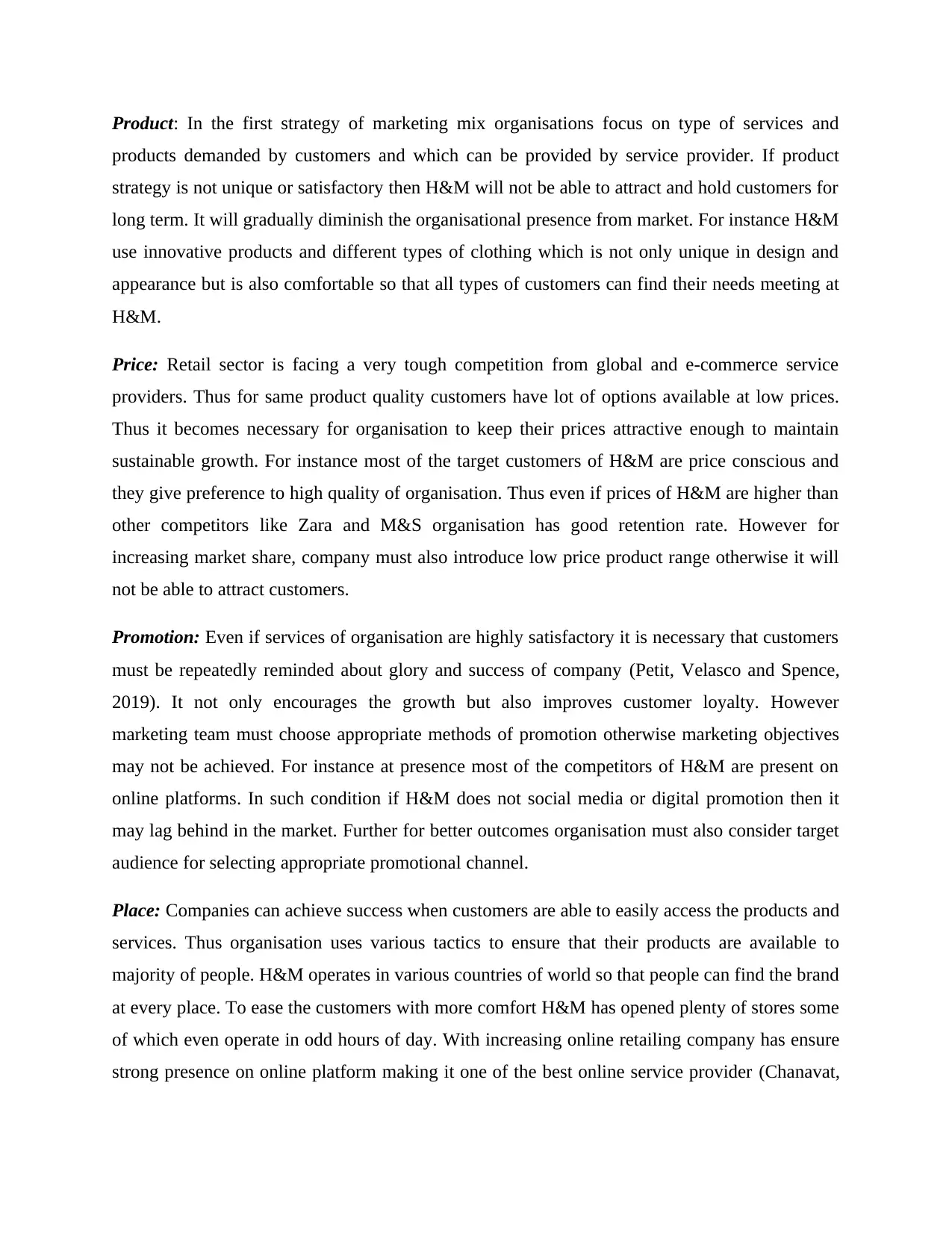
Product: In the first strategy of marketing mix organisations focus on type of services and
products demanded by customers and which can be provided by service provider. If product
strategy is not unique or satisfactory then H&M will not be able to attract and hold customers for
long term. It will gradually diminish the organisational presence from market. For instance H&M
use innovative products and different types of clothing which is not only unique in design and
appearance but is also comfortable so that all types of customers can find their needs meeting at
H&M.
Price: Retail sector is facing a very tough competition from global and e-commerce service
providers. Thus for same product quality customers have lot of options available at low prices.
Thus it becomes necessary for organisation to keep their prices attractive enough to maintain
sustainable growth. For instance most of the target customers of H&M are price conscious and
they give preference to high quality of organisation. Thus even if prices of H&M are higher than
other competitors like Zara and M&S organisation has good retention rate. However for
increasing market share, company must also introduce low price product range otherwise it will
not be able to attract customers.
Promotion: Even if services of organisation are highly satisfactory it is necessary that customers
must be repeatedly reminded about glory and success of company (Petit, Velasco and Spence,
2019). It not only encourages the growth but also improves customer loyalty. However
marketing team must choose appropriate methods of promotion otherwise marketing objectives
may not be achieved. For instance at presence most of the competitors of H&M are present on
online platforms. In such condition if H&M does not social media or digital promotion then it
may lag behind in the market. Further for better outcomes organisation must also consider target
audience for selecting appropriate promotional channel.
Place: Companies can achieve success when customers are able to easily access the products and
services. Thus organisation uses various tactics to ensure that their products are available to
majority of people. H&M operates in various countries of world so that people can find the brand
at every place. To ease the customers with more comfort H&M has opened plenty of stores some
of which even operate in odd hours of day. With increasing online retailing company has ensure
strong presence on online platform making it one of the best online service provider (Chanavat,
products demanded by customers and which can be provided by service provider. If product
strategy is not unique or satisfactory then H&M will not be able to attract and hold customers for
long term. It will gradually diminish the organisational presence from market. For instance H&M
use innovative products and different types of clothing which is not only unique in design and
appearance but is also comfortable so that all types of customers can find their needs meeting at
H&M.
Price: Retail sector is facing a very tough competition from global and e-commerce service
providers. Thus for same product quality customers have lot of options available at low prices.
Thus it becomes necessary for organisation to keep their prices attractive enough to maintain
sustainable growth. For instance most of the target customers of H&M are price conscious and
they give preference to high quality of organisation. Thus even if prices of H&M are higher than
other competitors like Zara and M&S organisation has good retention rate. However for
increasing market share, company must also introduce low price product range otherwise it will
not be able to attract customers.
Promotion: Even if services of organisation are highly satisfactory it is necessary that customers
must be repeatedly reminded about glory and success of company (Petit, Velasco and Spence,
2019). It not only encourages the growth but also improves customer loyalty. However
marketing team must choose appropriate methods of promotion otherwise marketing objectives
may not be achieved. For instance at presence most of the competitors of H&M are present on
online platforms. In such condition if H&M does not social media or digital promotion then it
may lag behind in the market. Further for better outcomes organisation must also consider target
audience for selecting appropriate promotional channel.
Place: Companies can achieve success when customers are able to easily access the products and
services. Thus organisation uses various tactics to ensure that their products are available to
majority of people. H&M operates in various countries of world so that people can find the brand
at every place. To ease the customers with more comfort H&M has opened plenty of stores some
of which even operate in odd hours of day. With increasing online retailing company has ensure
strong presence on online platform making it one of the best online service provider (Chanavat,
⊘ This is a preview!⊘
Do you want full access?
Subscribe today to unlock all pages.

Trusted by 1+ million students worldwide
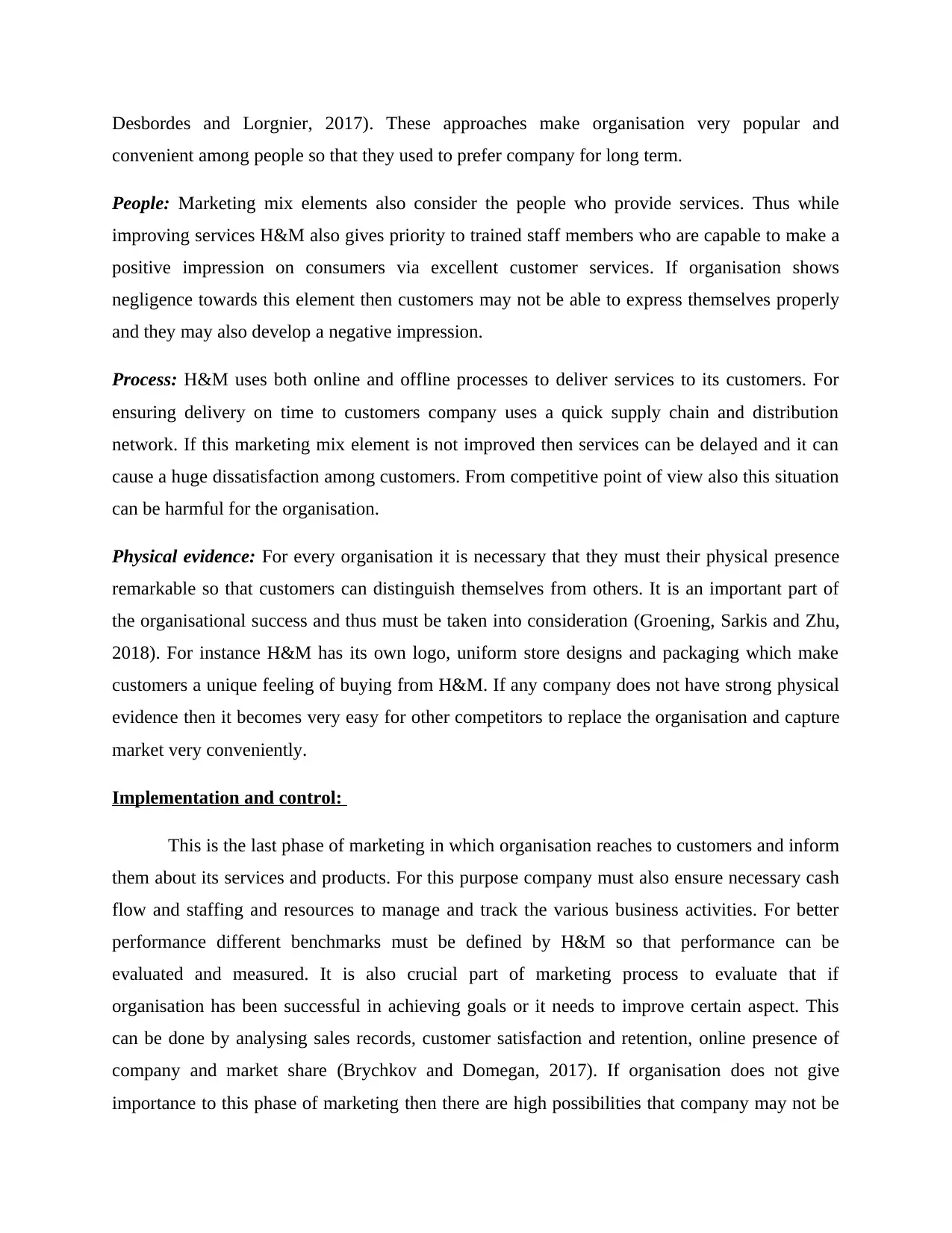
Desbordes and Lorgnier, 2017). These approaches make organisation very popular and
convenient among people so that they used to prefer company for long term.
People: Marketing mix elements also consider the people who provide services. Thus while
improving services H&M also gives priority to trained staff members who are capable to make a
positive impression on consumers via excellent customer services. If organisation shows
negligence towards this element then customers may not be able to express themselves properly
and they may also develop a negative impression.
Process: H&M uses both online and offline processes to deliver services to its customers. For
ensuring delivery on time to customers company uses a quick supply chain and distribution
network. If this marketing mix element is not improved then services can be delayed and it can
cause a huge dissatisfaction among customers. From competitive point of view also this situation
can be harmful for the organisation.
Physical evidence: For every organisation it is necessary that they must their physical presence
remarkable so that customers can distinguish themselves from others. It is an important part of
the organisational success and thus must be taken into consideration (Groening, Sarkis and Zhu,
2018). For instance H&M has its own logo, uniform store designs and packaging which make
customers a unique feeling of buying from H&M. If any company does not have strong physical
evidence then it becomes very easy for other competitors to replace the organisation and capture
market very conveniently.
Implementation and control:
This is the last phase of marketing in which organisation reaches to customers and inform
them about its services and products. For this purpose company must also ensure necessary cash
flow and staffing and resources to manage and track the various business activities. For better
performance different benchmarks must be defined by H&M so that performance can be
evaluated and measured. It is also crucial part of marketing process to evaluate that if
organisation has been successful in achieving goals or it needs to improve certain aspect. This
can be done by analysing sales records, customer satisfaction and retention, online presence of
company and market share (Brychkov and Domegan, 2017). If organisation does not give
importance to this phase of marketing then there are high possibilities that company may not be
convenient among people so that they used to prefer company for long term.
People: Marketing mix elements also consider the people who provide services. Thus while
improving services H&M also gives priority to trained staff members who are capable to make a
positive impression on consumers via excellent customer services. If organisation shows
negligence towards this element then customers may not be able to express themselves properly
and they may also develop a negative impression.
Process: H&M uses both online and offline processes to deliver services to its customers. For
ensuring delivery on time to customers company uses a quick supply chain and distribution
network. If this marketing mix element is not improved then services can be delayed and it can
cause a huge dissatisfaction among customers. From competitive point of view also this situation
can be harmful for the organisation.
Physical evidence: For every organisation it is necessary that they must their physical presence
remarkable so that customers can distinguish themselves from others. It is an important part of
the organisational success and thus must be taken into consideration (Groening, Sarkis and Zhu,
2018). For instance H&M has its own logo, uniform store designs and packaging which make
customers a unique feeling of buying from H&M. If any company does not have strong physical
evidence then it becomes very easy for other competitors to replace the organisation and capture
market very conveniently.
Implementation and control:
This is the last phase of marketing in which organisation reaches to customers and inform
them about its services and products. For this purpose company must also ensure necessary cash
flow and staffing and resources to manage and track the various business activities. For better
performance different benchmarks must be defined by H&M so that performance can be
evaluated and measured. It is also crucial part of marketing process to evaluate that if
organisation has been successful in achieving goals or it needs to improve certain aspect. This
can be done by analysing sales records, customer satisfaction and retention, online presence of
company and market share (Brychkov and Domegan, 2017). If organisation does not give
importance to this phase of marketing then there are high possibilities that company may not be
Paraphrase This Document
Need a fresh take? Get an instant paraphrase of this document with our AI Paraphraser
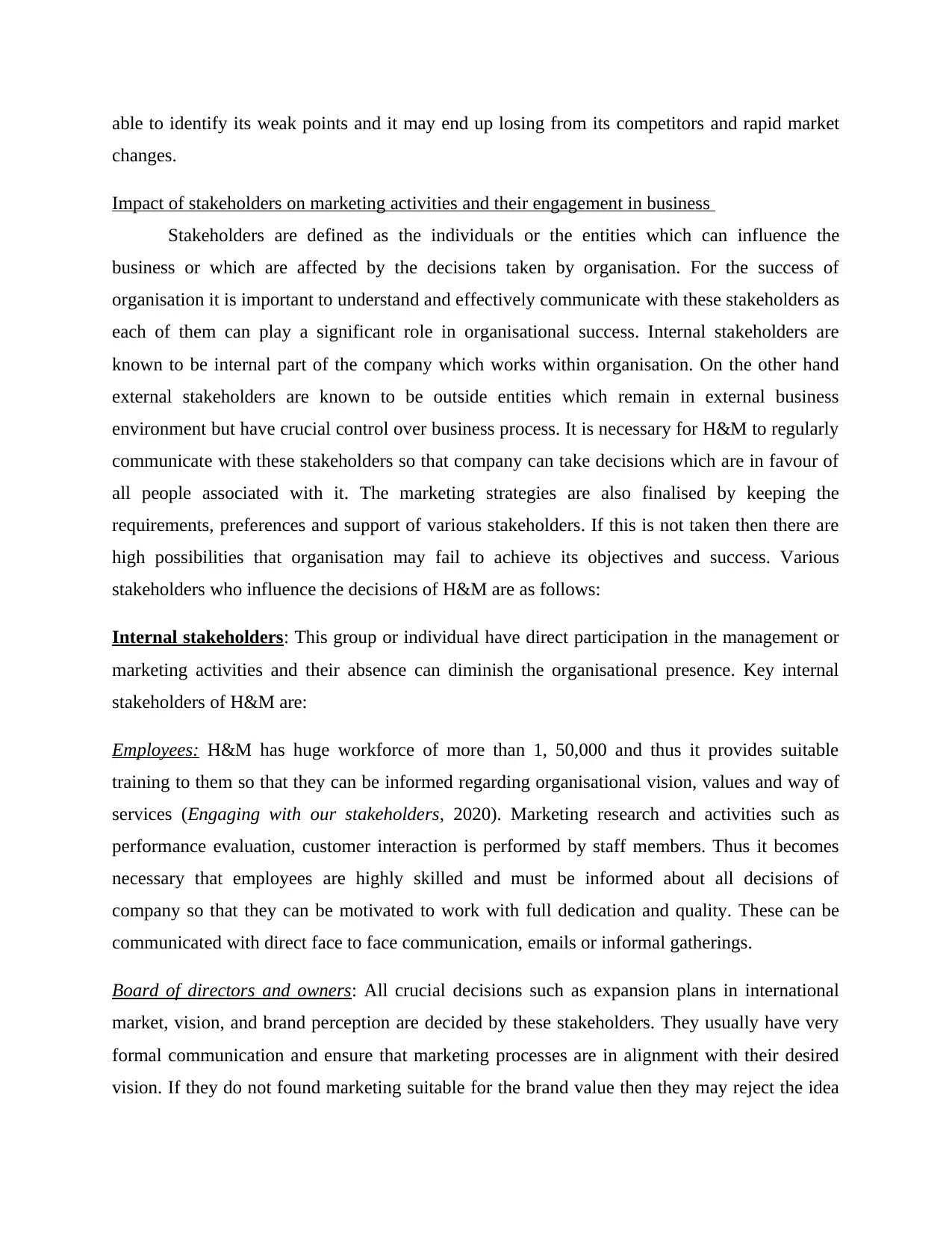
able to identify its weak points and it may end up losing from its competitors and rapid market
changes.
Impact of stakeholders on marketing activities and their engagement in business
Stakeholders are defined as the individuals or the entities which can influence the
business or which are affected by the decisions taken by organisation. For the success of
organisation it is important to understand and effectively communicate with these stakeholders as
each of them can play a significant role in organisational success. Internal stakeholders are
known to be internal part of the company which works within organisation. On the other hand
external stakeholders are known to be outside entities which remain in external business
environment but have crucial control over business process. It is necessary for H&M to regularly
communicate with these stakeholders so that company can take decisions which are in favour of
all people associated with it. The marketing strategies are also finalised by keeping the
requirements, preferences and support of various stakeholders. If this is not taken then there are
high possibilities that organisation may fail to achieve its objectives and success. Various
stakeholders who influence the decisions of H&M are as follows:
Internal stakeholders: This group or individual have direct participation in the management or
marketing activities and their absence can diminish the organisational presence. Key internal
stakeholders of H&M are:
Employees: H&M has huge workforce of more than 1, 50,000 and thus it provides suitable
training to them so that they can be informed regarding organisational vision, values and way of
services (Engaging with our stakeholders, 2020). Marketing research and activities such as
performance evaluation, customer interaction is performed by staff members. Thus it becomes
necessary that employees are highly skilled and must be informed about all decisions of
company so that they can be motivated to work with full dedication and quality. These can be
communicated with direct face to face communication, emails or informal gatherings.
Board of directors and owners: All crucial decisions such as expansion plans in international
market, vision, and brand perception are decided by these stakeholders. They usually have very
formal communication and ensure that marketing processes are in alignment with their desired
vision. If they do not found marketing suitable for the brand value then they may reject the idea
changes.
Impact of stakeholders on marketing activities and their engagement in business
Stakeholders are defined as the individuals or the entities which can influence the
business or which are affected by the decisions taken by organisation. For the success of
organisation it is important to understand and effectively communicate with these stakeholders as
each of them can play a significant role in organisational success. Internal stakeholders are
known to be internal part of the company which works within organisation. On the other hand
external stakeholders are known to be outside entities which remain in external business
environment but have crucial control over business process. It is necessary for H&M to regularly
communicate with these stakeholders so that company can take decisions which are in favour of
all people associated with it. The marketing strategies are also finalised by keeping the
requirements, preferences and support of various stakeholders. If this is not taken then there are
high possibilities that organisation may fail to achieve its objectives and success. Various
stakeholders who influence the decisions of H&M are as follows:
Internal stakeholders: This group or individual have direct participation in the management or
marketing activities and their absence can diminish the organisational presence. Key internal
stakeholders of H&M are:
Employees: H&M has huge workforce of more than 1, 50,000 and thus it provides suitable
training to them so that they can be informed regarding organisational vision, values and way of
services (Engaging with our stakeholders, 2020). Marketing research and activities such as
performance evaluation, customer interaction is performed by staff members. Thus it becomes
necessary that employees are highly skilled and must be informed about all decisions of
company so that they can be motivated to work with full dedication and quality. These can be
communicated with direct face to face communication, emails or informal gatherings.
Board of directors and owners: All crucial decisions such as expansion plans in international
market, vision, and brand perception are decided by these stakeholders. They usually have very
formal communication and ensure that marketing processes are in alignment with their desired
vision. If they do not found marketing suitable for the brand value then they may reject the idea
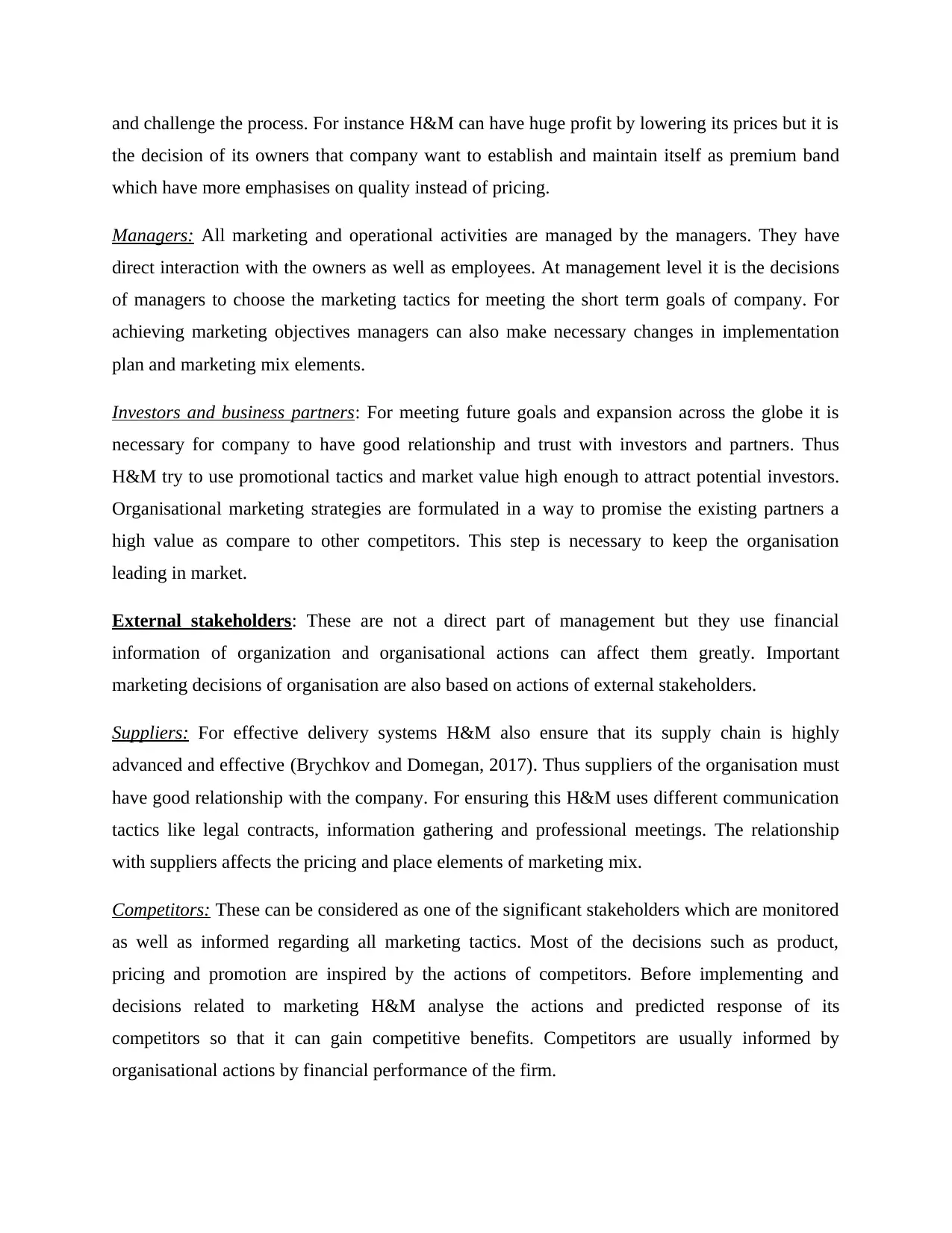
and challenge the process. For instance H&M can have huge profit by lowering its prices but it is
the decision of its owners that company want to establish and maintain itself as premium band
which have more emphasises on quality instead of pricing.
Managers: All marketing and operational activities are managed by the managers. They have
direct interaction with the owners as well as employees. At management level it is the decisions
of managers to choose the marketing tactics for meeting the short term goals of company. For
achieving marketing objectives managers can also make necessary changes in implementation
plan and marketing mix elements.
Investors and business partners: For meeting future goals and expansion across the globe it is
necessary for company to have good relationship and trust with investors and partners. Thus
H&M try to use promotional tactics and market value high enough to attract potential investors.
Organisational marketing strategies are formulated in a way to promise the existing partners a
high value as compare to other competitors. This step is necessary to keep the organisation
leading in market.
External stakeholders: These are not a direct part of management but they use financial
information of organization and organisational actions can affect them greatly. Important
marketing decisions of organisation are also based on actions of external stakeholders.
Suppliers: For effective delivery systems H&M also ensure that its supply chain is highly
advanced and effective (Brychkov and Domegan, 2017). Thus suppliers of the organisation must
have good relationship with the company. For ensuring this H&M uses different communication
tactics like legal contracts, information gathering and professional meetings. The relationship
with suppliers affects the pricing and place elements of marketing mix.
Competitors: These can be considered as one of the significant stakeholders which are monitored
as well as informed regarding all marketing tactics. Most of the decisions such as product,
pricing and promotion are inspired by the actions of competitors. Before implementing and
decisions related to marketing H&M analyse the actions and predicted response of its
competitors so that it can gain competitive benefits. Competitors are usually informed by
organisational actions by financial performance of the firm.
the decision of its owners that company want to establish and maintain itself as premium band
which have more emphasises on quality instead of pricing.
Managers: All marketing and operational activities are managed by the managers. They have
direct interaction with the owners as well as employees. At management level it is the decisions
of managers to choose the marketing tactics for meeting the short term goals of company. For
achieving marketing objectives managers can also make necessary changes in implementation
plan and marketing mix elements.
Investors and business partners: For meeting future goals and expansion across the globe it is
necessary for company to have good relationship and trust with investors and partners. Thus
H&M try to use promotional tactics and market value high enough to attract potential investors.
Organisational marketing strategies are formulated in a way to promise the existing partners a
high value as compare to other competitors. This step is necessary to keep the organisation
leading in market.
External stakeholders: These are not a direct part of management but they use financial
information of organization and organisational actions can affect them greatly. Important
marketing decisions of organisation are also based on actions of external stakeholders.
Suppliers: For effective delivery systems H&M also ensure that its supply chain is highly
advanced and effective (Brychkov and Domegan, 2017). Thus suppliers of the organisation must
have good relationship with the company. For ensuring this H&M uses different communication
tactics like legal contracts, information gathering and professional meetings. The relationship
with suppliers affects the pricing and place elements of marketing mix.
Competitors: These can be considered as one of the significant stakeholders which are monitored
as well as informed regarding all marketing tactics. Most of the decisions such as product,
pricing and promotion are inspired by the actions of competitors. Before implementing and
decisions related to marketing H&M analyse the actions and predicted response of its
competitors so that it can gain competitive benefits. Competitors are usually informed by
organisational actions by financial performance of the firm.
⊘ This is a preview!⊘
Do you want full access?
Subscribe today to unlock all pages.

Trusted by 1+ million students worldwide
1 out of 15
Related Documents
Your All-in-One AI-Powered Toolkit for Academic Success.
+13062052269
info@desklib.com
Available 24*7 on WhatsApp / Email
![[object Object]](/_next/static/media/star-bottom.7253800d.svg)
Unlock your academic potential
Copyright © 2020–2025 A2Z Services. All Rights Reserved. Developed and managed by ZUCOL.





